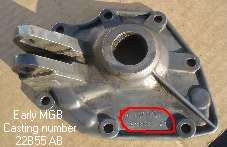The MGA With An Attitude
Question:
e.) New gasket and seal for the gearbox front cover. YES! Finally, this time you get a real oil seal for the front. The new front cover and seal bolt right up and work with the original MGA input shaft. This seal is the same for the late production MGA MK-II and all MGB front covers. You will need to pay attention to getting the shims right for the front bearing when you change the cover. For advance preparation you may want to buy a couple new bearing shims. f.) New MGB clutch release bearing. Be sure you have the correct retaining clips for it (clips should come with the new release bearing, but no guarantee). I do NOT recommend the roller release bearings, as ther are too many reports of premature failure of those parts. g.) New bushing and pivot bolt for the clutch release arm (usually needed). This is also a good time to check the clutch slave cylinder rubber bits, push rod and clevis pin. You might get a decent used push rod and clevis pin with the MGB release arm, but don't bet on it, as these parts wear out fairly quickly. These parts are the same for the A and B, including the clutch slave cylinder. However the Twin Cam and Deluxe must use an original slave cylinder as it has a much smaller bore than the pushrod engine unit. If a larger bore standard MGA or MGB clutch slave cylinder is used in the Twin Cam chassis it will not give enough clutch pushrod movement. h.) New spigot bushing for the back end of the MGA crankshaft. Dirt cheap, usually in need of renewing, seldom given instructions, easy to change if you know the tricks. See engine section for Spigot Bushing Replacement. i.) You may likely need a new ring gear if you just bought a used flywheel. This is not a terribly expensive part, and is a good time to renew it if in need. And you CAN replace it yourself. Instructions usually come with the new ring gear, but can be a little vague. Check FW-101 for the skinny on how to throw a friendly backyard Ring Gear Barbeque. Okay, slight time warp forward, now you have your clean 3-pin flywheel with a good ring gear (either MGA or MGB flywheel), your MGA clutch disk, and the other parts. In case it hasn't dawned on you yet, all the parts from the pressure plate back to the face of the gearbox will be the MGB parts (except maybe the friction disk). From here assembly is the same as with the MGA parts, with one exception. As the pivot point for the release arm is now a little farther forward than it used to be, it's going to be a little tight getting the bottom end of the release arm past the front cover and through the large slot in the side of the bellhousing. You may have to use a file or hand grinder to bevel the inside edge of the housing a bit right at the front of the slot to allow the bottom yoke of the release arm to sneak through. Otherwise it's a tinker toy set, just bolt it all back together, by the book. Do pay particular attention to the gearbox assembly instructions to properly fit the correct bearing shims inside the gearbox front cover. And when you get it all back in the car, happy motoring. (You're gonna love it!) I did this conversion in late 1993, using a low starter MGA 1500 gearbox. I have since run a stock MGB pressure plate, then a competition pressure plate, then another new stock MGB pressure plate. I have also used both early 1500 and mid 1500 type low starter gearboxes. There has been no problem with clearances in these setups. However, there may be a slight interference issue with the MGA 1600 high starter gearbox, and a more serious issue with more recent issue MGB replacement clutch covers. See following page CT-102A for some possible interference issues with the MGB clutch inside of the MGA bellhousing. |
